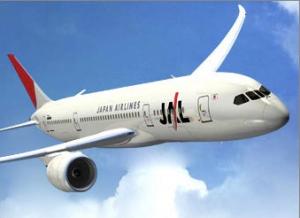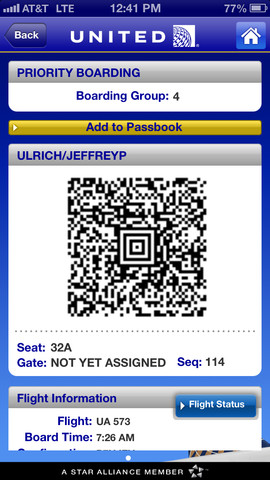Two Major Airlines Diverge on Initial Approach to NFC

Japan Airlines plans to expand its use of NFC for boarding and other services at domestic airports this year, while U.S.-based United Airlines is sticking with mobile bar codes, at least for now, considering that 80% of the users of its mobile apps carry iPhones.
Representatives of the two major airlines–in comments last Friday at the WIMA 2013 NFC conference in Monaco and in interviews with NFC Times–appeared to echo the debate going on in the airline industry over how best to move away from bar codes for mobile customers, if at all.
As NFC Times reported last month, the International Air Transport Association, which represents 240 airlines worldwide, plans to finish its evaluation of NFC technology this year and could propose standards to its members in October. Among the issues under discussion is whether to put boarding passes or other passenger ID onto SIM cards or other secure elements in NFC phones.
Japan Airlines, or JAL, which last fall introduced what is believed to be the world’s first commercial boarding service using standard NFC technology, plans to expand the service to all three of Japan’s major mobile operators this year, including NTT DoCoMo and Softbank Mobile, Toshi Shimizu, director for JAL’s Web sales planning group, told NFC Times. The airline had already introduced the NFC boarding service in the fall with No. 2 Japanese telco KDDI, storing customers’ frequent flyer numbers on the telco’s NFC SIM cards.
JAL has offered mobile boarding and other airport services for the past seven years with contactless mobile phones based on FeliCa technology from Sony Corp., which is similar to NFC. Rival All Nippon Airways also has offered FeliCa-mobile services.
Japanese mobile operators last year started moving to phones that support both FeliCa and standard NFC applications. And in 2012, Japan ranked among the top two countries worldwide, along with South Korea, in issuing NFC SIM cards.
“For the future, the key to maximize our experience is to help people be able to use NFC service, not just in their own country but also in their own region,” Shimizu said during his presentation at WIMA.
It remains to be seen how fast JAL moves to NFC services using the type A or B protocols in the NFC standard. It will continue to offer FeliCa-based services, which enable customers to tap their phones to pass through boarding gates and security checkpoints, enter lounges, pay for purchases in airport shops and, in some cases, onboard airplanes, as well as tapping tags in smart posters at airport kiosks.
The FeliCa technology makes for fast boarding, noted Shimizu, who showed a video that he said demonstrated that JAL could board 90% of the passengers in a 500-passenger aircraft in just 10 minutes. About 70% of the customers in the video tapped FeliCa frequent flyer cards or FeliCa-based phones, while the rest used paper boarding passes with bar codes. In general, the percentages of people using FeliCa cards or phones are usually not that high for JAL.
Faster than Bar Codes
Shimizu told NFC Times that tests showed customers with FeliCa cards or phones took an average of just 1.8 seconds to pass through boarding gates, compared with 2.3 to 2.5 seconds on average for bar codes.
While the NFC standard includes FeliCa, applications based on FeliCa technology in Japan use a proprietary protocol, so users of standard NFC phones could not tap to pay at FeliCa terminals in stores, at subway gates or airline boarding gates.
Shimizu said he believes FeliCa-based wallet phones as well as standard NFC phones are simpler for customers to use with boarding passes because they only have to tap the phones, compared with bar codes that have to be positioned properly to be scanned. The contactless phones require less assistance from airline staff.
“So it makes the boarding process very smooth,” he said. “The accuracy is so reliable that now we only need one ground staff and one cabin crew to assist at the gate.”
United Not Yet Sold on NFC
Shimizu said that of JAL customers that use smartphones for mobile services, 60% carry Android devices and 40% pack iPhones.
Jeff Ulrich, senior manager of innovation at United, noted that the ratio of Android to iOS devices is much different among mobile app users at United, at which about 80% carry the iPhone and about 20% an Android device. That makes NFC a nonstarter at United for now. Besides its iOS app, United was one of the original partners offering services in Apple’s Passbook wallet, introduced last fall.
“So I think some of our challenge in the U.S. is, until Apple (adopts NFC) or there’s a viable solution using an iOS device, it’s kind of a hard sell to our senior management, because we have something that works with mobile boarding with QR codes with iOS devices.”
 In response to a question from NFC Times, Ulrich said he could see advantages for NFC over bar codes if customers were able to use the phones when the device is out of battery power.
In response to a question from NFC Times, Ulrich said he could see advantages for NFC over bar codes if customers were able to use the phones when the device is out of battery power.
“Really, I think that what a lot of the airlines are looking for: What makes the customer experience better?” he said. “And currently, one of the issues with QR codes–if your battery runs out of power, you’re dead. You can’t pull it (boarding pass) up. You can’t show it.”
He said bar codes also require a bit more work by customers to transmit their boarding passes at gates than NFC would if the latter could work in power-off mode, drawing all or most of its power from the contactless reader.
“Let’s say I’m on a round-trip, and I’m going and returning in a day, and I’ve got four passes on there,” Ulrich said. “I have to pull up an app, sort through, get a QR code, line it up, make sure it doesn’t twist or turn, (so it could) read correctly.”
On the other hand, customers could transmit the correct boarding pass with just a tap of the NFC phone.
“When I tap the phone, the reader figures out which pass to read and lets me through,” he said. “So there’s no interaction on the customer. Even if my phone’s dead, I don’t have to worry about it.”
The problem is, in order to work without power to the phone, the boarding pass would have to be stored on a secure element, probably a SIM card, and would communicate with the reader in card-emulation mode. The single-wire protocol SIM standard is designed to be able to work without drawing juice from the battery.
Secure-Element Issue
But putting boarding passes onto SIM cards adds complexity, and many mobile operators plan to charge service providers for using space on their SIMs, Ulrich noted. Moreover, boarding passes don’t require the security of a SIM or other smart card chip.
“Who’s going to pay that fee?” he asked. “Right now, we’re using QR codes or paper or various different options that are not costing us to distribute, so that has to be discussed.”
The need for secure elements with NFC-enabled airline applications is one of the issues the International Air Transport Association, or IATA, will have to decide on if it adopts NFC for boarding passes and other uses at airports and for airlines. Even without power-off mode, it would be fastest to use card emulation to transmit boarding passes, compared with other modes of communication possible with NFC phones. And card emulation requires a secure element.
The GSMA mobile operator trade group is pushing the SIM-based approach, and GSMA member France Telecom-Orange confirmed it plans to launch an NFC trial this fall with Air France of SIM-based boarding passes at the regional Toulouse-Blagnac Airport. Geneva-based airline industry IT and communications services provider SITA, a proponent of NFC technology as a way to eventually replace what it considers cumbersome 2-D bar codes, is working on the Air France NFC pilot and other trials for airlines.
But while United’s Ulrich said his airline has tested NFC with tags in smart posters in a couple of airports to help deliver gate and other flight information, among other customer education, United appears to have no plans, at present, to test NFC-enabled boarding passes. QR codes work fine, he said.
“We’re not dissatisfied with current (bar-code) methods,” he told NFC Times. “There have to be compelling reasons to move to NFC.”












